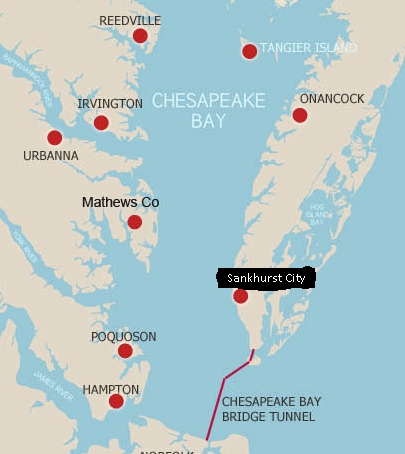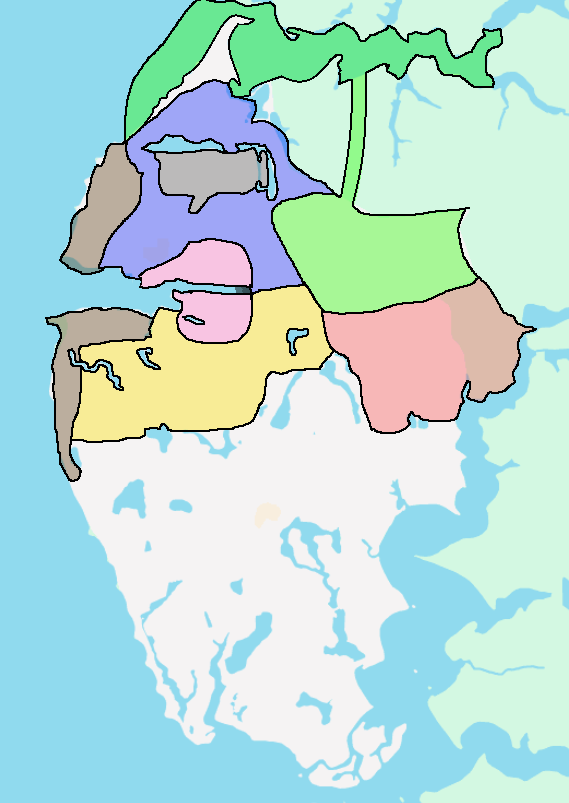Sankhurst Physical Structure

Sankhurst is located where modern day Cape Charles is, on a peninsula near Chesapeake Bay:

Sankhurst is divided into several zones. The following zones are labeled on the map:
- Residential (High-Density) - Blue
- Business (High-Density) - Yellow
- Mixed-Use (High-Density) - Pink
- Municipal (High-Density) - Grey
- Hydroponics - Lime
- Docks - Brown
- Manufacturing - Red
Every high-density zone is built to have three floors below-ground, and four floors above-ground, for a total of seven floors. Sankhurst is in the line of tropical storms, which can and has damaged buildings with floors higher than that. This allows for high-density operations without the need for tall buildings, since the building's lower levels can be secured into the ground itself.
City expansion is limited by two things: the groundwater in surrounding areas, and the tropical storms that ravage the coast Sankhurst is based on. All Governors in the past have been hesitant to expand, primarily due to the difficulty of maintaining that much land, come a storm a calling. Buildings are stout with basement levels instead of building up further.
The municipal zone of the city has bunkers in it to protect from essence-density related effects. When the city of Sankhurst fails in drawing in enough essence to prevent it from building up to a high level, citizens take refuge in the bunkers. Emergency glyph-burning stacks are finished to draw a ton of essence out of the air, which allows the city to return to normal.
Finally, most streets in Sankhurst have streetcars built on them. Streetcars are propelled using force glyphs along a cable, held on the track by a rail system. These are managed by Infrastructure and Transit.
In addition, for travel outside of Sankhurst, sleds are produced by Industry and given lease by City Hall for residents of businesses. More details about sleds is under Factories.
Municipal buildings are a mix of department buildings and City Hall. This is smack-dab in the center of the residential district, to be as accessible to citizens as possible.
- City Hall - Contains the living quarters, receiving hall, and office of the Governor of Sankhurst.
- Sustenance - Manages receiving, processing, and distributing foodstuffs from fishing and Hydroponics, as well as water distribution.
- Mining - Manages the collection of common and rare materials necessary for manufacturing, and its transportation.
- Industry - Manages materials, production, and workplace safety inside each factory and production line.
- Infrastructure and Transit - Manages infrastructure related to roads, buildings, and the ways that citizens get to them.
- Housing - Manages the allotment, maintenance, and upgrading of housing in Sankhurst.
- Enforcement - Manages law enforcement, penalties, and arrests/imprisonment for any criminal activity.
- Commerce - Manages business activity, revenue flow, and public works.
- Health - Manages public health, healthcare facilities.
- Education - Manages educational facilities for jobs, youth, and specialized roles within the city.
Additionally, the Municipal zone contains a series of storm shelters, built to two levels underground. When tropical storms, empowered by essence or not, hit the city, acoustic glyphs are sounded to get the citizens. They are reinforced to avoid this.
Culture
Sankhurst has a culture of subsistence. The city and its populace are in a perpetual precarious position, and careful management of its populace, space, and resource usage are necessary to keep it afloat. They are completely isolated from any other cities or towns; the only people outside of Sankhurst, to their knowledge, are the mining outputs (explained in next section), leading to a kind of... "We're the last ones, no one will save us."
This has led to the motto of Sankhurst being "No One Else Will". It is the ironclad will of the people: no one else will do this, so I must. Nearly every citizen of Sankhurst has a high skill in self-discipline, as this ideal is taught from the start of schooling, to job training, to every moment someone does something. No one else will, so I must. This is reinforced by every interaction one has in Sankhurst; no actions of kindness, but of necessity. This person needs help, no one else will help, so I will. There's some government messaging reinforcing it, but only in education and training for jobs.
However, there are some cultural notes. Sankhurst is comprised of hard, weary people, where cooperation is prioritized above all else. Generally, selfish actions are less common due to common need. Additionally, there is a culture of crafts. Essence workers craft specialized glyphs for citizen use.
There's some public works, such as sculpting, painting, and others. Citizens showing artistic talents are given the opportunity to work creatively, for the purposes of morale. Paintings are very uncommon, given the lack of dyes, but sculpture and more esoteric art are common. Glyph-based art (light sculptures, acoustic art) is common, requiring an understanding of essence work.
Any artists employed by the Sankhurst government do not spend all their time making art pieces; they must hold a job, either in the factories or in private businesses in Sankhurst.
There are three public history museums: the Museum of Essence Work, the Museum of Sankhurst, and the Museum of Manufacturing. Each details the history of their chosen topic, and are constantly added to as advancements are made. These serve as introductions into what keep Sankhurst afloat, as well as what to be proud of in the city.
Mining
Mining is done outside of Sankhurst, across what we'd describe as modern-day Virginia. A series of mines are established around areas that were known, prior to the essence explosion event two hundred years ago, to be rich in natural ore required for manufacturing.
Digging in general is done via a specialized glyph; it shoots force through the ground, several times a second, for over a minute. It completely breaks down dirt, bedrock, and some ores, allowing separate teams to gather crushed ore up, sift it, then ready it for transfer to Sankhurst. This allows for teams to be solely focused on the retrieval, sorting, and delivery of materials, rather than delegating large amounts of people to mining.
These mining outposts require staff, and so citizens of Sankhurst are deployed to it on trips to collect ore. They do not return until their time out there is up, and once they do, they are highly rewarded. The dangers of mining require that reward: essence density outside of Sankhurst (effects described in Essence document) requires a high level of risk from people on those outposts.
There is also digging for clay, which is transferred back to Sankhurst for further processing.
Government
Government in Sankhurst is maintained by the Municipal departments outlined above, but the decisions are made by the Governor of Sankhurst. The governor is an autocratic position, who provides direction for the city's departments and hears appeals from citizens. Governors serve until death or retirement, at which point their will dictates a successor. If no successor is given, the heads of Enforcement, Sustenance, Mining, Industry, Infrastructure and Transit, Housing, Commerce, Health, and Education, in that order, are selected to be the next Governor.
Over the 200 years of recorded history after the essence crisis, the Governorship system of rule was preceded by a council. However, the Logistics representative for that council decided to overthrow the existing council and institute an autocratic rule, with him at the lead. The coup was successful, though it could barely be called a coup. More details in a currently unwritten work.
The autocratic rule of the Governor has proceeded without much cause for failure for the next two hundred years. Most citizens are happy under the rule; it was instituted to stop the inefficiencies that result from needed quorum, and every Governor has named a worthy successor. This long-present system has resulted in a Title forming: the Governor Title, which is inherited by each new Governor of Sankhurst.
However, there's also a growing section of unhappiness in regards to the Governorship system of rule, especially given previous Governors' decisions and how they affected the populace. This has lead to a group establishing themselves as petitioners for a less autocratic rule, but so far, they haven't been effective.
They will be the main driving force for the plot, spurring Geneviah and Saetowards overthrowing the Governorship way of power of establishing a new council, discovering the cause behind the essence crisis and embarking on a quest to fix it.
Commerce
Commerce in the city of Sankhurst is based around a credit system. Every citizen's name is in books handled by the Commerce department, with a given number for the assets and debts, along with purchase history.
When a purchase is made at a private business in Sankhurst, the product or service that was purchased is on hold until it is verified with Commerce. Once it is verified, the purchaser can return to the private business to finish with the transaction.
However, for time-critical purchases, a temporary grant can be allowed per-business to take the item or set up the service that day. However, if the purchase is found to be invalid, it can result in consequences from Commerce.
The specifics of these is left up to the writer, none will be defined here.
All citizens have their credit count upped to two hundred if it is below that; this allows citizens to keep the economy flowing.
Education
Education in Sankhurst is government-funded and controlled. General education is done from nine years old to seventeen; starting at the basics and traveling towards specialties, based on a determination of what your skills are geared towards.
These are in the "Business" zoning of Sankhurst.
In addition to general education, there are facilities for learning how to etch glyphs by hand, learning how to create art using various methods, learning the basics of how the factories/agriculture zones operate, and learning how to work on the from the docks.
All those facilities are typically taught by experienced masters for that area of work, to educate students. Each master typically takes on at least four students at once.
The time taken for education varies, but masters are compensated by their work per-session. This is to encourage fast progress to avoid payments. If a student or master is struggling with the subject, an Education liaison steps in to verify they are the right fit.
Education also holds competency tests for all students pronounced fit by their teacher; if the student fails this, they are not allowed to work in the field in which they were taught, and the teacher is proctored to verify they are instructing properly.
This has led to some friction between masters of their field and Education; masters view them as a blocker towards true instruction, while Education views the masters, at the worst, as unqualified wrecks poisoning students' minds. To be fair, there are some truly terrible teachers for specific fields, but Education has seen them, and it's hard not to assume the worst.
Healthcare
Healthcare is strained in Sankhurst, given the lack of modern-day advancements. Saving people from disease is hard, so instead, the city prioritizes preventing disease. Soap for handwashing and knowledge for hygiene are handed out like candy.
Exposure to endemic diseases as a child in safe conditions to gain immunity later in life is very common, given someone has the disease. This is usually a rotating cycle; adults who have had the disease spread it to children, who grow up immune, who then can't spread it to their kids.
Healthcare clinics are spread across every zone; basic first aid is given, along with specific practitioner requests for midwifery, infection management, and chronic disease management.
Medical practitioners are deployed to the mining outposts for on-site medical assistance, but recovery from injury and death are statistically lower in on outposts.
Mental Health
Mental health is primarily managed by peer support groups. One-on-one care is very uncommon; typically only done in extreme cases where group therapy would be ineffective.

